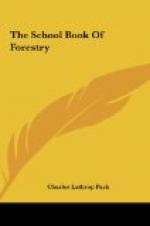Our eastern forests are practically exhausted. Our supplies of export lumber except Douglas fir are declining. Most of the kinds of export timber that Europe wants we need right at home. We have only about 258,000,000,000 feet of southern yellow pine left, yet this material composes one-half of our annual shipments abroad. We are cutting this material at the rate of 16,000,000,000 board feet a year. Some authorities believe that our reserves will last only sixteen years unless measures to protect them are put into effect at once. At the present rate of cutting long-leaf pine trees, our outputs of naval stores including turpentine and rosin are dwindling. We cannot afford to increase our export of southern yellow pine unless reforestation is started on all land suitable for that purpose. Our pine lands of the southern states must be restocked and made permanently productive. Then they could maintain the turpentine industry, provide all the lumber of this kind we need for home use, and supply a larger surplus for export.
Although our supplies of Douglas fir, western white pine, sugar pine and western yellow pine are still large, they will have to bear an extra burden when all the southern pine is gone. This indicates that the large supplies of these woods will not last as long as we would wish. To prevent overtaxing their production, it is essential that part of the load be passed to the southern pine cut-over lands. By proper protection and renewal of our forests, we can increase our production of lumber and still have a permanent supply. The Forest Service estimates that by protecting our cut-over and waste lands from fire and practicing care to secure reproduction after logging on our remaining virgin forest land, we can produce annually at least 27,750,000,000 cubic feet of wood, including 70,000,000,000 board feet of sawtimber. Such a production would meet indefinitely the needs of our growing population, and still leave an amount of timber available for export.
Our hardwoods need protection as well as our softwoods. Ten per cent of our yearly cut of valuable white oak is shipped overseas. In addition we annually waste much of our best oak in the preparation of split staves for export. At the present rate of cutting, the supply, it is said, will not last more than twenty-five years. We ship abroad about seven per cent. of our poplar lumber. Our supplies of this material will be exhausted in about twenty years if the present rate of cutting continues. We sell to foreign countries at least one-half of our cut of black walnut which will be exhausted in ten to twelve years unless present methods are reformed. Our supplies of hickory, ash and basswood will be used up in twenty to thirty years. We need all this hardwood lumber for future domestic purposes. However, the furniture factories of France, Spain and Italy are behind on orders. They need hardwood and much of our valuable hardwood timber is being shipped to Europe.




